tow CHEVROLET CAVALIER 1994 1.G User Guide
[x] Cancel search | Manufacturer: CHEVROLET, Model Year: 1994, Model line: CAVALIER, Model: CHEVROLET CAVALIER 1994 1.GPages: 243, PDF Size: 15.06 MB
Page 95 of 243
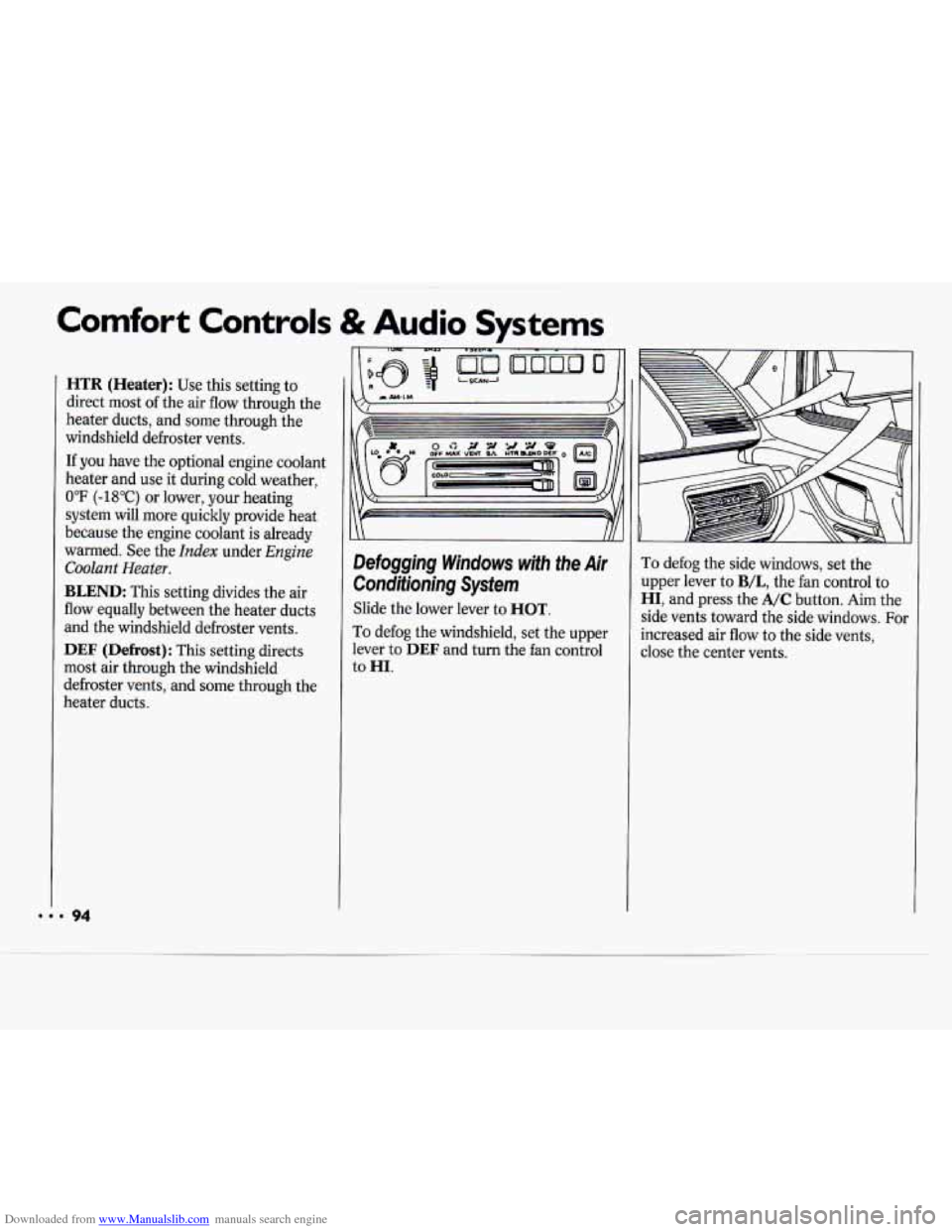
Downloaded from www.Manualslib.com manuals search engine Comfort Controls & Audio Systems
HTR (Heater): Use this setting to
direct most of the air flow through the
heater ducts, and some through the
windshield defroster vents.
If you have the optional engine coolant
heater and use it during cold weather,
0°F (-18°C) or lower, your heating
system will more quickly provide heat
because the engine coolant is already
warmed. See the
Index under Engine
Coolant Heater.
BLEND: This setting divides the air
flow equally between the heater ducts
and the windshield defroster vents.
DEF (Defrost): This setting directs
most air through the windshield
defroster vents, and some through the
heater ducts.
Defogging Windows with the Air
Conditioning System
Slide the lower lever to HOT.
To defog the windshield, set the upper
lever
to DEF and turn the fan control
to
HI.
To defog the side windows, set the
upper lever to
B/L, the fan control to
HI, and press the A/C button. Aim the
side vents toward the side windows. For
increased air flow to the side vents,
close the center vents.
... 94
Page 108 of 243
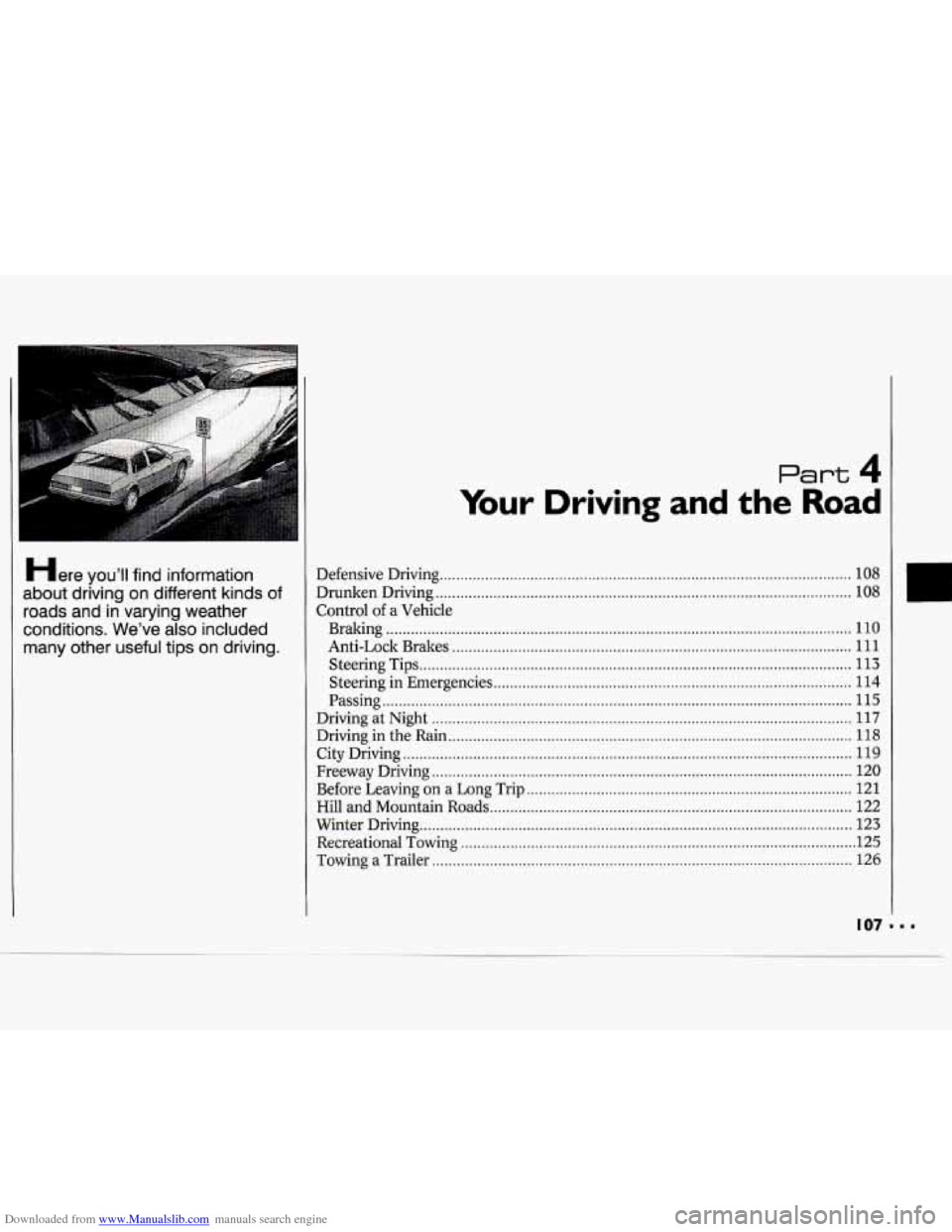
Downloaded from www.Manualslib.com manuals search engine Here you’ll find information
about driving on different kinds
of
roads and in varying weather
conditions
. We’ve also included
many other useful tips on driving
.
107
Part 4
Your Driving and the Road
Defensive Drlvmg 108
Drunken Driving
........................................................................\
............................. 108
Control
of a Vehicle
Braking
........................................................................\
......................................... 110
Anti-Lock Brakes
........................................................................\
......................... 111
Steering Tips ........................................................................\
................................. 113
Steermg m Emergencies ........................................................................\
............... 114
Passing
........................................................................\
.......................................... 115
Driving at Night ........................................................................\
.............................. 117
Driving in the Rain
........................................................................\
.......................... 118
City Driving ........................................................................\
..................................... 119
Freeway Driving
........................................................................\
.............................. 120
Before Leaving on a Long Trip
........................................................................\
....... 121
Hill and Mountain Roads
........................................................................\
................ 122
Winter Drnmg 123
Recreational Towing
........................................................................\
........................ 125
Towing a Trailer
........................................................................\
.............................. 126
.. ........................................................................\
............................
..
.. ........................................................................\
.................................
......... ~
Page 126 of 243
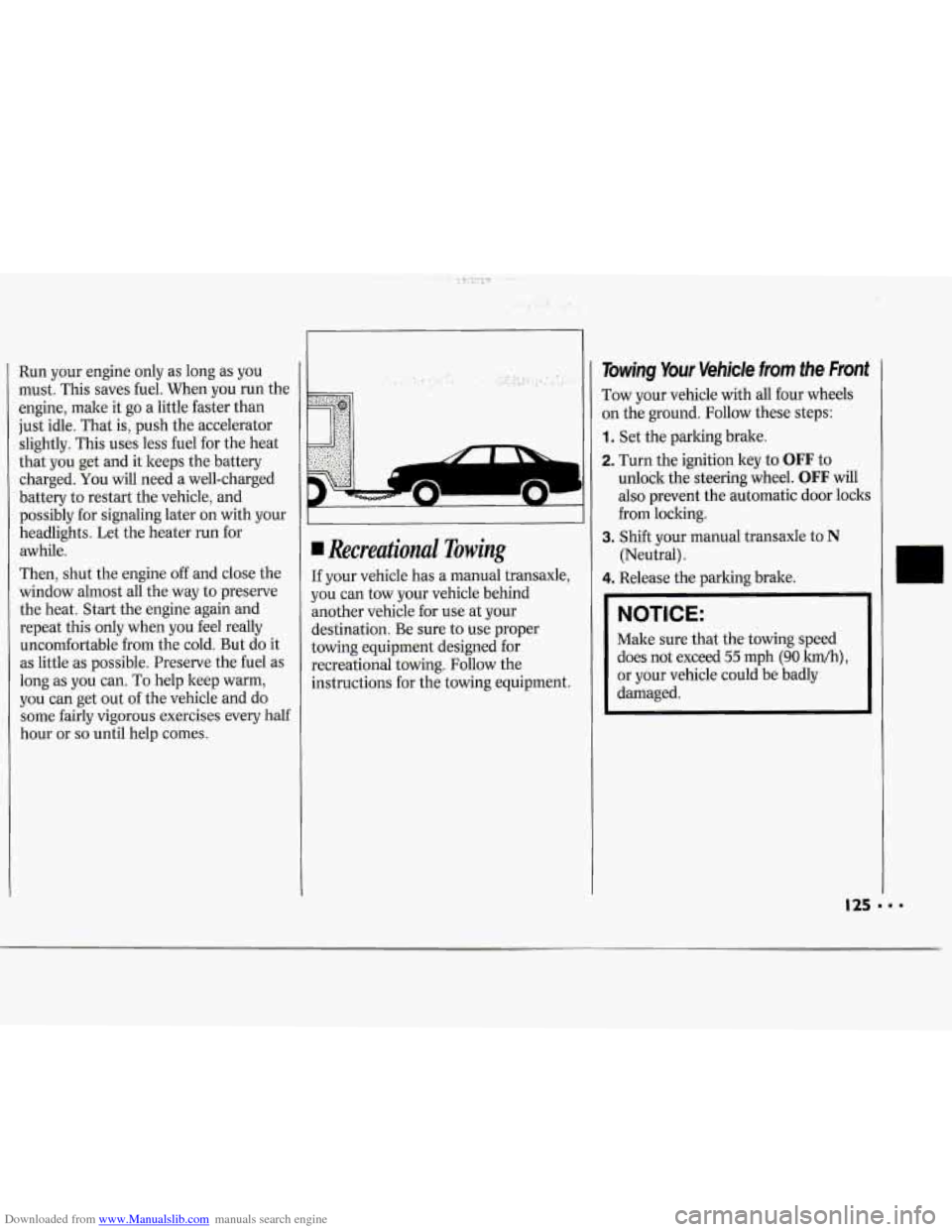
Downloaded from www.Manualslib.com manuals search engine Run your engine only as long as you
must. This saves fuel. When you run the
engine, malte it go a little faster than
just idle. That is, push the accelerator
slightly. This uses less fuel for the heat
that you get and it keeps the battery
charged.
You will need a well-charged
battery to restart the vehicle, and
possibly
for signaling later on with your
headlights. Let the heater run for
awhile.
Then, shut the engine
off and close the
window almost all the way to preserve
the heat. Start the engine again and
repeat this only when you feel really
uncomfortable
from the cold. But do it
as little as possible. Preserve the fuel as
long as
you can. To help keep warm,
you can get out
of the vehicle and do
some fairly vigorous exercises every half
hour or so until help comes.
~~
Recreational Towing
If your vehicle has a manual transaxle,
you can tow your vehicle behind
another vehicle for use at your
destination. Be sure
to use proper
towing equipment designed for
recreational towing. Follow the
instructions for the towing equipment.
Towing Your Vehicle from the Front
Tow your vehicle with all four wheels
on the ground. Follow these steps:
1. Set the parking brake.
2. Turn the ignition key to OFF to
unlock the steering wheel.
OFF will
also prevent the automatic door locks
from locking.
(Neutral).
3.
Shift your manual transaxle to
N
4. Release the parking brake.
NOTICE:
Make sure that the towing speed
does not exceed
55 mph (90 lm),
or your vehicle could be badly
damaged.
Page 127 of 243
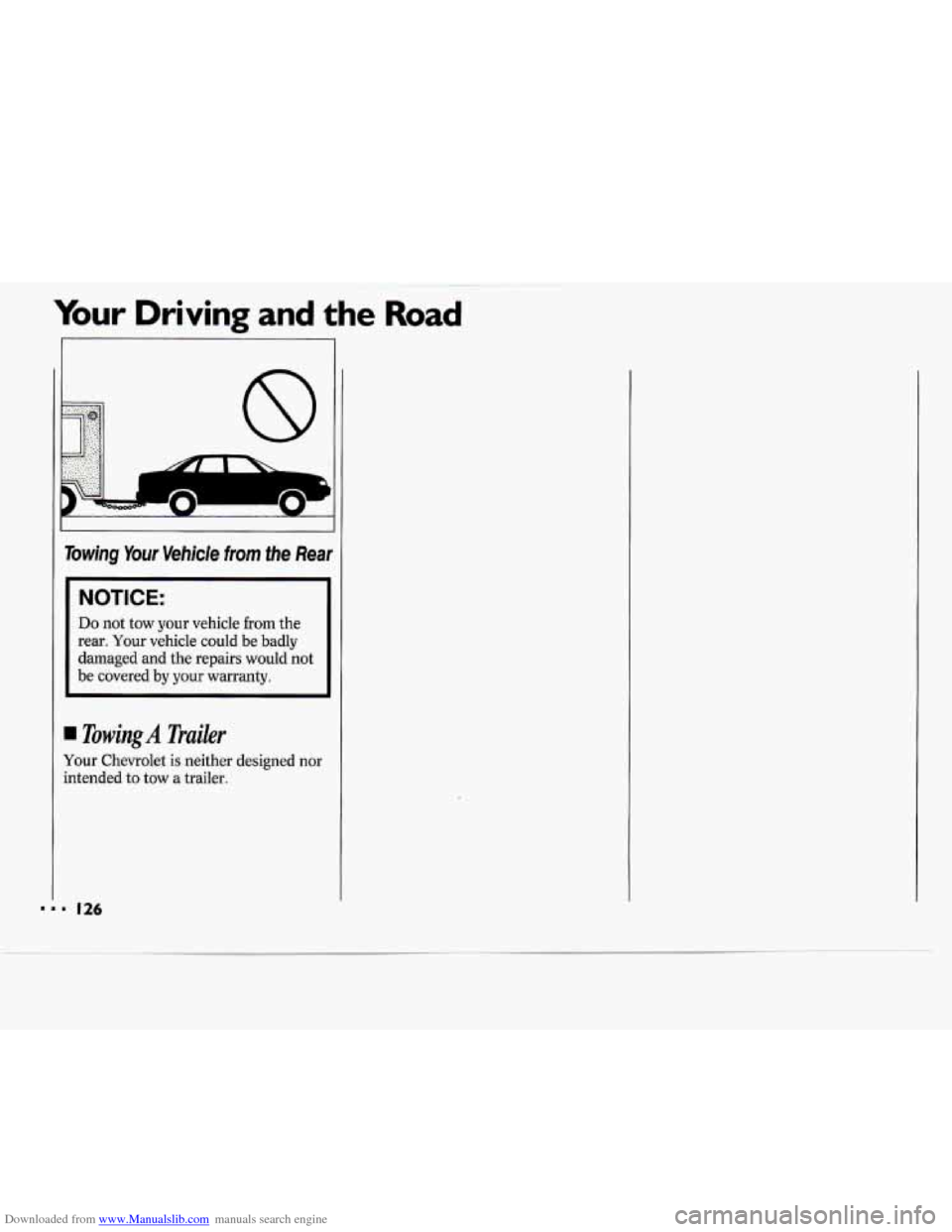
Downloaded from www.Manualslib.com manuals search engine Your Driving and the Road
n 0
Towing Your Vehicle from the Rear
I NOTICE:
Do not tow your vehicle from the
rear. Your vehicle could be badly
damaged and the repairs would not
be covered by your warranty.
Towing A Trailer
Your Chevrolet is neither designed nor
intended
to tow a trailer.
Page 128 of 243
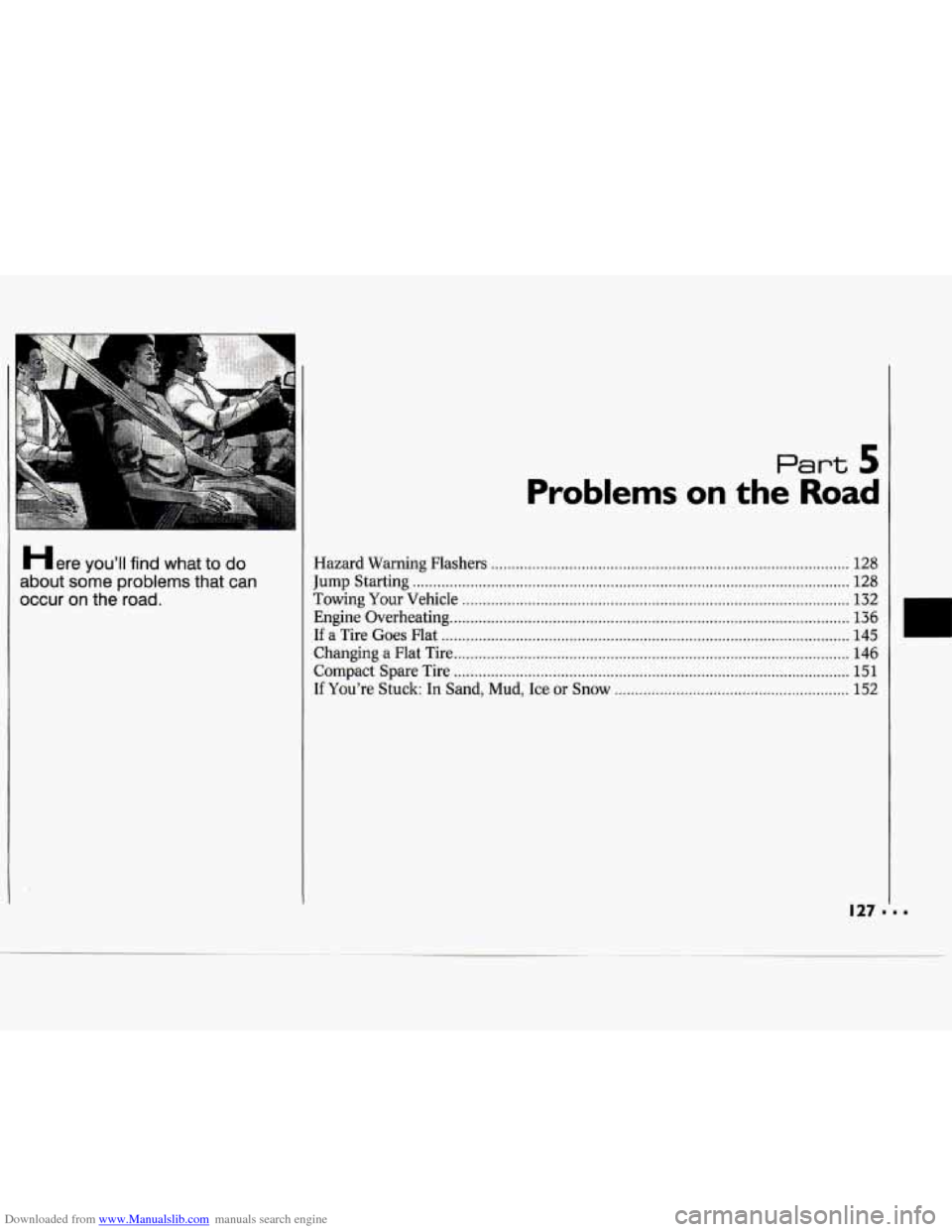
Downloaded from www.Manualslib.com manuals search engine Here you’ll find what to do
about some problems that can
occur
on the road .
Part 5
Problems on the Road
Hazard Warning Flashers ........................................................................\
............... 128
Jump Starting
........................................................................\
.................................. 128
Towing Your Vehicle
........................................................................\
...................... 132
Engine Overheating
........................................................................\
......................... 136
If a Tire Goes Flat ........................................................................\
........................... 145
Changing a Flat Tire
........................................................................\
........................ 146
Compact Spare Tire ........................................................................\
........................ 151
If You’re Stuck: In Sand, Mud, Ice or Snow
......................................................... 152
Page 133 of 243
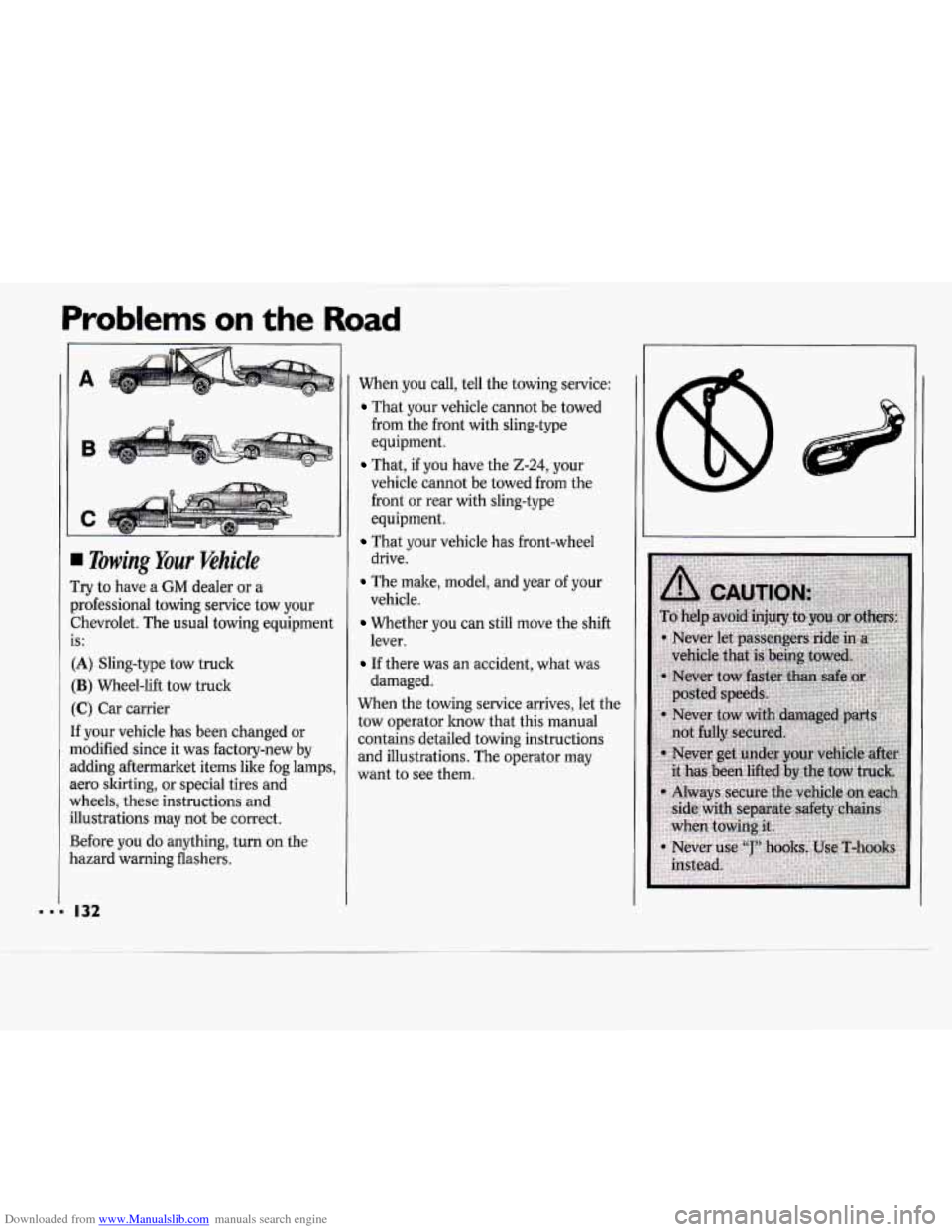
Downloaded from www.Manualslib.com manuals search engine Problems on the Road
-
A
B
I Towing Your Vehicle
Try to have a GM dealer or a
xofessional towing service tow your
Zhevrolet. The usual towing equipment
:A) Sling-type tow truck
:B) Wheel-lift tow truck
C) Car carrier
f your vehicle has been changed or
nodified since it was factory-new by
ldding aftermarket items like fog lamps,
iero skirting, or special tires and
uheels, these instructions and
llustrations may not be correct.
Before you do anything, turn on the
lazard warning flashers.
S:
When you call, tell the towing service:
That your vehicle cannot be towed
from the front with sling-type
equipment.
That, if you have the 2-24, your
vehicle cannot
be towed from the
front or rear with sling-type
equipment.
drive.
vehicle. lever.
damaged.
That your vehicle has front-wheel
The make, model, and year of your
Whether you can still move the shift
If there was an accident, what was
When the towing service arrives, let the
tow operator know that this manual
contains detailed towing instructions
and illustrations. The operator may
want to see them.
.I I32
Page 134 of 243
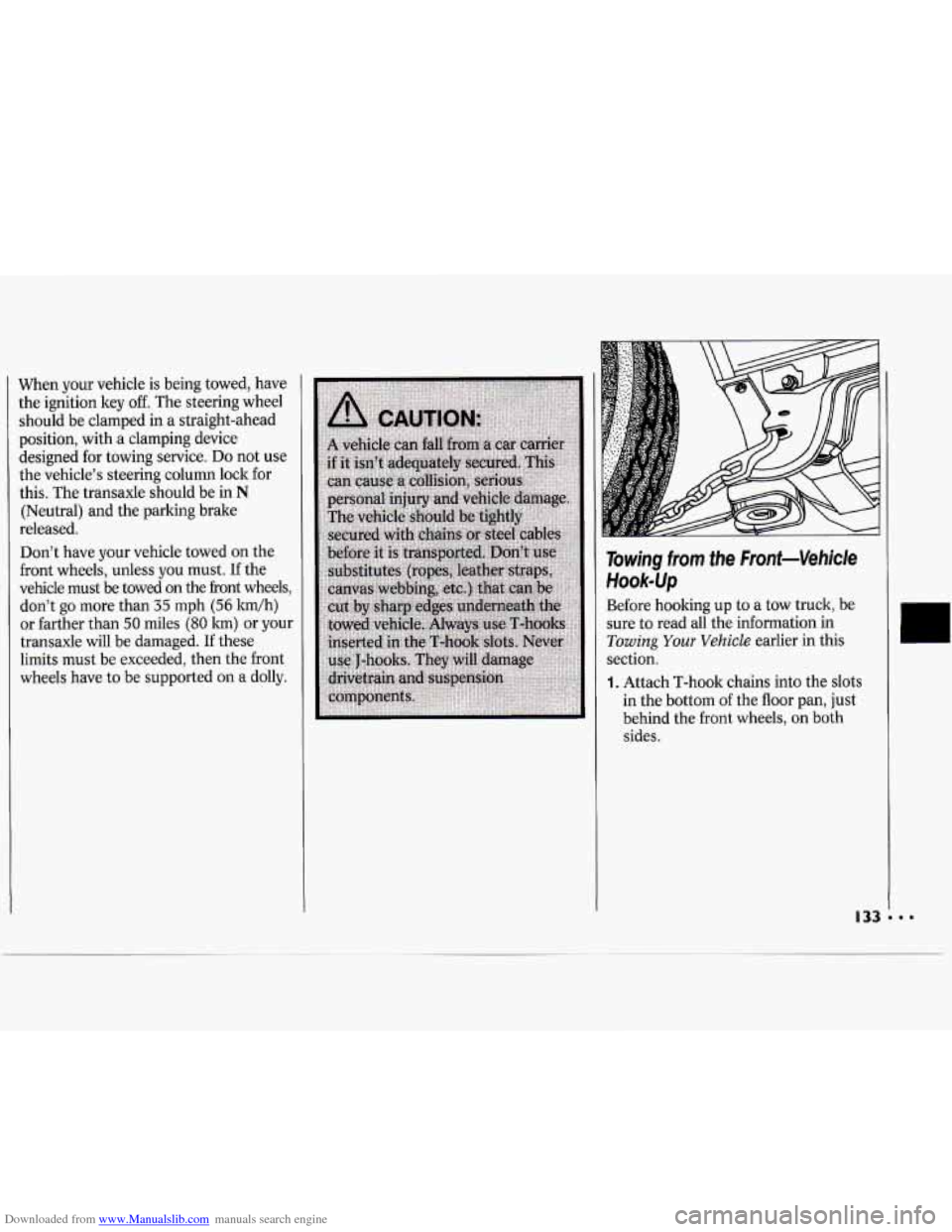
Downloaded from www.Manualslib.com manuals search engine When your vehicle is being towed, have
the ignition key
off. The steering wheel
should be clamped in a straight-ahead
position, with a clamping device
designed for towing service.
Do not use
the vehicle’s steering column lock for
this. The transaxle should be in
N
(Neutral) and the parking brake
released.
Don’t have your vehicle towed
on the
front wheels, unless you must. If the
vehicle must be towed
on the front wheels,
don’t
go more than 35 mph (56 kdh)
or farther than
50 miles (80 lun) or your
transaxle will be damaged.
If these
limits must be exceeded, then the front
wheels have to be supported on a dolly.
Towing from the Front-Vehicle
Hookup
Before hooking up to a tow truck, be
sure to read all the information in
Towing Your Vehicle earlier in this
section.
1. Attach T-hook chains into the slots
in the bottom
of the floor pan, just
behind the front wheels, on both
sides.
Page 135 of 243
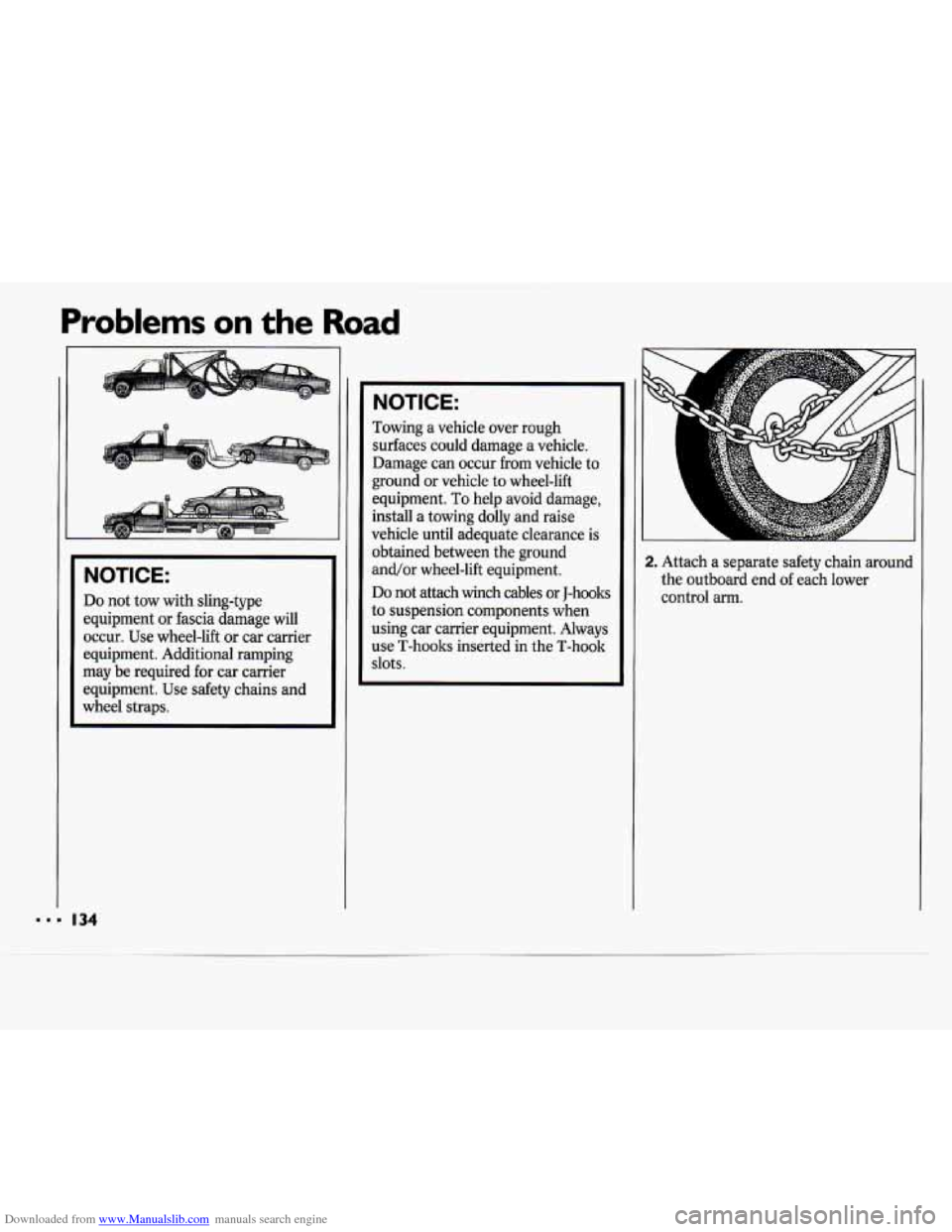
Downloaded from www.Manualslib.com manuals search engine Problems on the Road
NOTICE:
Do not tow with sling-type
equipment or fascia damage will
occur. Use wheel-lift or car carrier
equipment. Additional ramping
may be required for car carrier
equipment. Use safety chains and
wheel straps.
NOTICE:
Towing a vehicle over rough
surfaces could damage a vehicle.
Damage can occur from vehicle
to
ground or vehicle to wheel-lift
equipment.
To help avoid damage,
install a towing dolly and raise
vehicle until adequate clearance is
obtained between the ground
and/or wheel-lift equipment.
Do not attach winch cables or J-hooks
to suspension components when
using car carrier equipment. Always
use T-hooks inserted
in the T-hook
slots.
2. Attach a separate safety chain around
the outboard end
of each lower
control arm.
Page 136 of 243
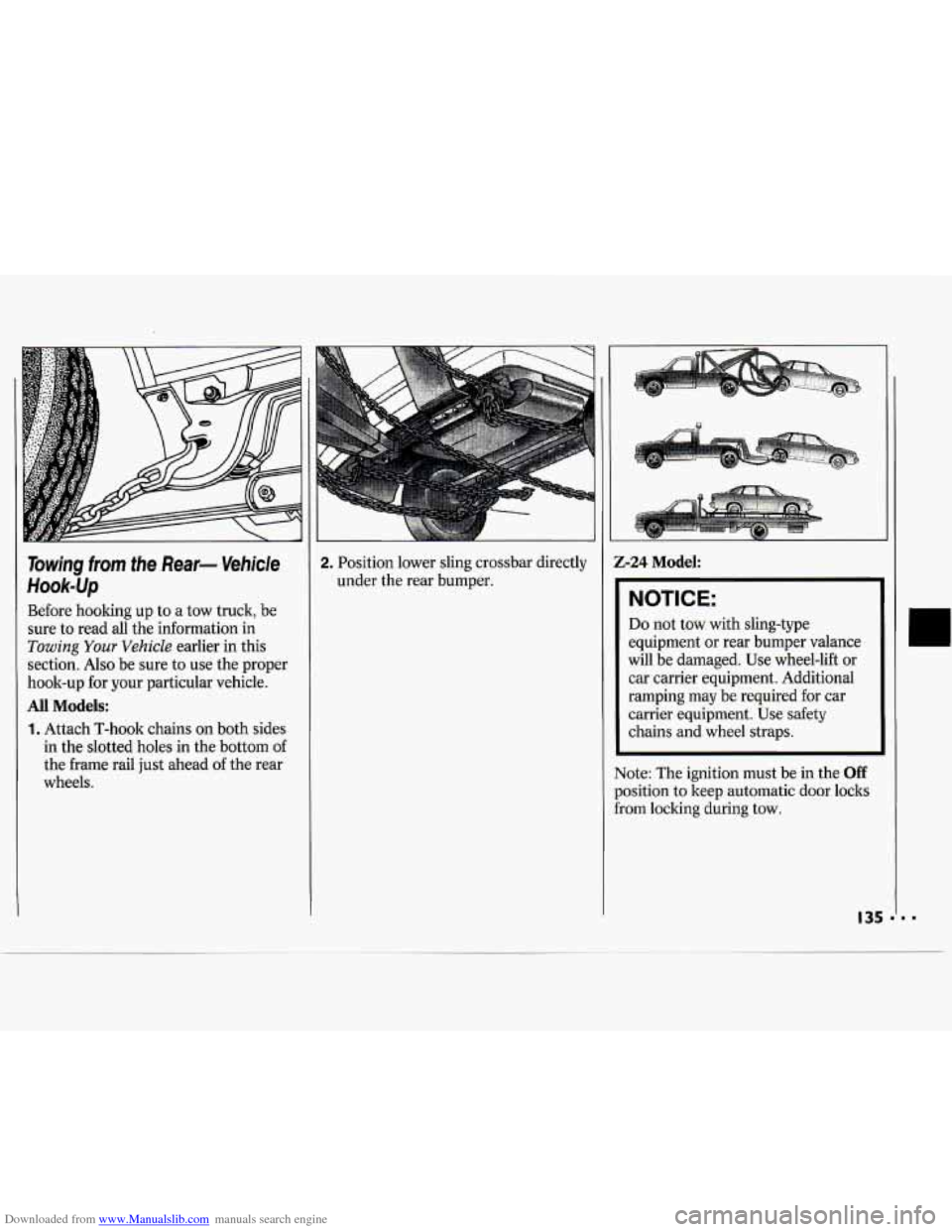
Downloaded from www.Manualslib.com manuals search engine Towing from the Rear- Vehicle
Hook-up
Before hooking up to a tow truck, be
sure to read all the information in
Towing Your Vehicle earlier in this
section.
Also be sure to use the proper
hook-up for your particular vehicle.
All Models:
1. Attach T-hook chains on both sides
in the slotted holes in the bottom
of
the frame rail just ahead of the rear
wheels.
2. Position lower sling crossbar directly
under the rear bumper.
I-
-24 Model:
NOTICE:
Do not tow with sling-type
equipment or rear bumper valance
will be damaged. Use wheel-lift
or
car carrier equipment. Additional
ramping may be required for car
carrier equipment. Use safety
chains and wheel straps.
~~
ote: The ignition must be in the Off
Isition to keep automatic door locks
3m locking during tow.
I
I
135 11 -
Page 137 of 243
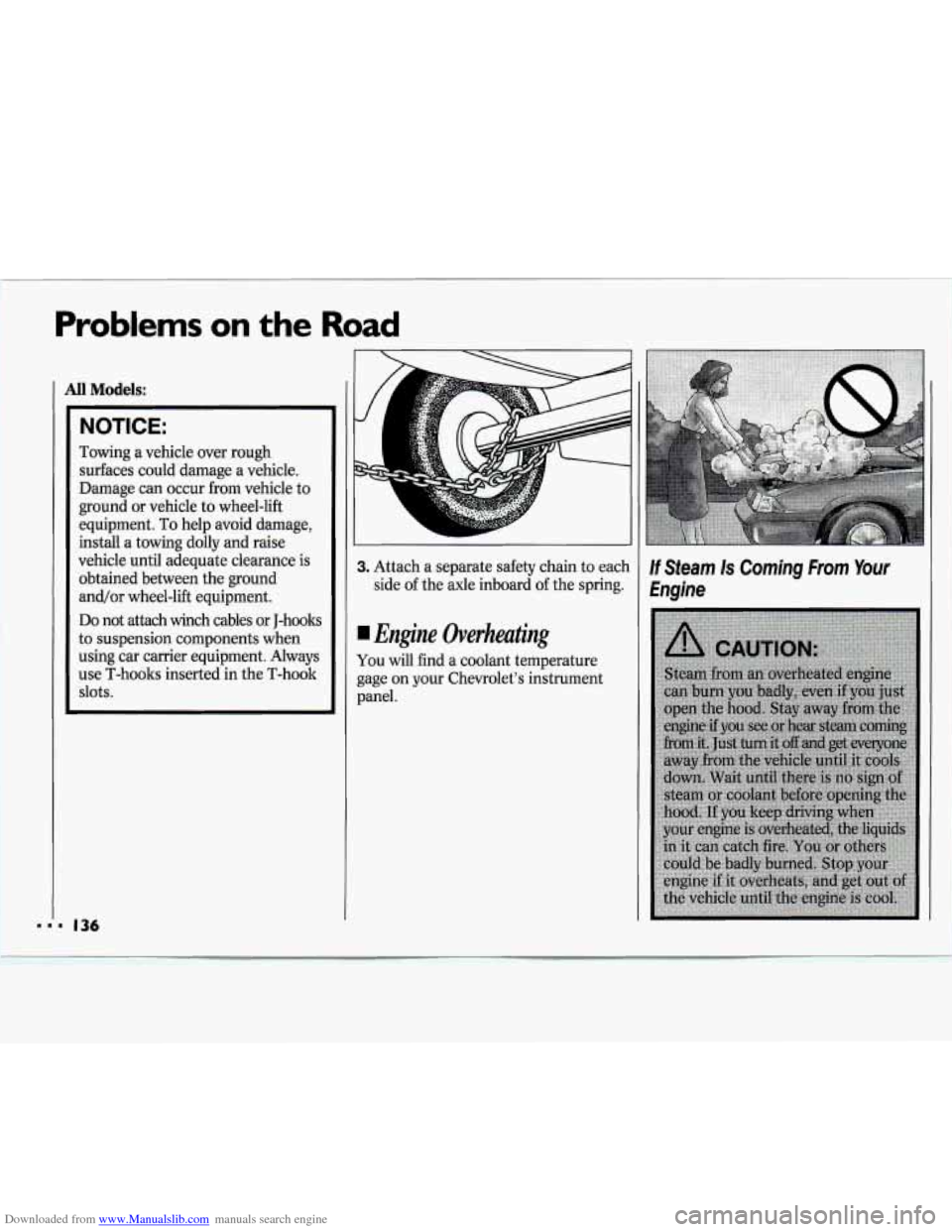
Downloaded from www.Manualslib.com manuals search engine Problems on the Road
All Models:
NOTICE:
Towing a vehicle over rough
surfaces could damage a vehicle.
Damage can occur from vehicle to
ground or vehicle to wheel-lift
equipment. To help avoid damage,
install a towing dolly and raise
vehicle until adequate clearance is
obtained between the ground
and/or wheel-lift equipment.
Do not attach winch cables or J-hooks
to suspension components when
using car carrier equipment. Always
use T-hooks inserted in the T-hook
slots.
r I I
3. Attach a separate safety chain to each
side of the axle inboard
of the spring.
Engine Overheating
You will find a coolant temperature
gage on your Chevrolet’s instrument
panel.
If Steam Is Coming From Your
Engine